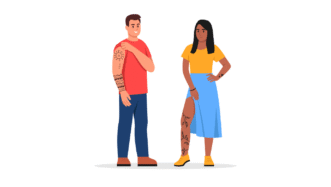LESSON OVERVIEW
This lesson plan demonstrates how we can use videos to teach grammar. This worksheet deals with reported speech and is based on a video, “Vogue 73 Questions with Nicole Kidman”. And here is the best part. You can choose whatever video interview you want to show your students. Vogue provides a lot of 73 questions videos with different celebrities, models, actresses, sportspeople (around 40). You can decide what your students might be interested in most and use it to practise reported speech – the lesson plan is developed in such a way that it gives you flexibility to choose whichever video you want.
PRESENTATION & PRACTICE (REPORTED SPEECH)
This reported speech lesson plan starts with a fake interview consisting of four questions and answers. Students need to read it and complete the table with direct and reported speech sentences. Next, they move to rules. They have to study the table and choose the correct option to form grammar rules about reported speech. Monitor your class and make sure that everyone understands how reported speech works. Finally, student practise using the structure. They need to rewrite provided sentences which represent different tenses and include time markers so that they can practise all aspects of reported speech.
VIDEO
Tell your students that they’re going to watch an interview with a famous person. Below you can find a video interview with Nicole Kidman that we’ve chosen. The 73 questions format by Vogue is a bit demanding. It’s a single shot video during which the interviewer asks a lot of random questions as the interviewee is giving a tour of their houses. What we usually do is to let students watch first 90 seconds of the video so they get familiar with the format. After this intro, you may also ask them to predict what kind of questions might be asked.
In the listening comprehension task, students have to write down 7 answers they hear in the video. Remind your students that they don’t need to remember and understand all the questions and answers. Those Vogue videos are a bit long so it’s up to you whether you want to play the whole video or just a few minutes. After that, using the answers they wrote down, students have to report what this famous person said.
PRODUCTION (PRACTISING REPORTED SPEECH WITH ROLE PLAY)
Next, students move to the production stage where they’ll practise newly-learnt grammar structure orally. First, they have to choose one famous person they would like to speak to if they had such an opportunity. Then, they write 5 questions they would ask such a person. Try to monitor and check whether your students have created correct direct questions.
Students work in pairs and give each other the name of the person they’ve chosen to interview. They have around 2 minutes to prepare for an interview with their partner, who will have to take on the role of that celebrity. It doesn’t really matter if they know the celebrity – let them improvise and not to worry whether their answers are true. Students who ask questions have to remember as many answers as they can. Finally, using reported speech, they have to tell the group/other people in the class what this famous person, i.e. their partner, said, e.g. Michelle Obama said that….
EXTRA WORKSHEET – Reporting verbs with movie quotes
As the lesson plan is all about reported speech, we want to supplement it with some reporting verbs so that your students can practise using more diverse vocabulary. With our worksheet called Movie quotes you should know!, your students will learn some classic movie quotes and use them to practise using reported speech. On top of that, there is a semi-controlled production task where students need to be a bit creative and come up with some original celebrity quotes and then report them.
WORKSHEETS
Subscribe to unlock these and many other Standalone lesson with the Premium plan
Subscribe














Hi, Could you explain this answer please as I am little confused about it
When we report questions, we should have the same/different word order than in questions. Answer shows different word order.
Yes, exactly. When we report a question, we have to change the word order as it is no longer a question (and in writing there is no question mark). The word order is like that of a normal statement (subject-verb-object).
Hey there
My students’ve found Nicole’s accent to be quite challenging to understand, so I substituted it with a different actress – Sarah Jessica Parker (https://www.youtube.com/watch?v=W511rtnnlZM&t=135s). For B1 students that video was perfect.
Thanks for your comment! Exactly, we can choose here any interview by Vogue which we find suitable for our students.
Thank you for your help! I could find the worksheets! Excellent materials!!
Thank you! very useful! I am learning all about computing skills these days! Thank you for the help!
Hi! Thanks for the class. I’d just like to let you know there’s a mistake on the worksheet and the slides:
Activity 1 (direct speech – indirect speech):
“I’ve always dreamt of seeing you in that show” said Joe’s father
Joe’s father said that he ______________ of seeing me in your show!
You probably forgot to change the pronouns in the indirect speech sentence.
The class was amazing, though! Thanks for everything!
Hi! Thanks for spotting that! You’re correct. We’ve just updated the worksheets and the slides 🙂
Hi! I think, there is a mistake in the sentence in the reported speech: David said that Joe is a master at
storytelling! I guess, Joe was, right?
Hi there! Actually, it’s not a mistake and the sentence you’ve mentioned refers to the rule in the next exercise (ex. 2), i.e. ‘if something that a person says is still true we can keep the same tense’.
The link to 73 questions in the lesson plan description seems to be broken – I used this one and it worked –
https://www.youtube.com/@Vogue/search?query=73%20questions
I like the lesson!
I’m happy you like it and thank you for letting us know! I’ve just updated the link 🙂
My students (Czechs) found this lesson very difficult. The first exercise is extremely confusing. They don’t understand the logic they need to follow to fill in the gaps.
I had to guide them the whole time and provide the correct answers.
They got tired after this first activity, and creating rules by analyzing the examples in the table made them even more irritated.
On the top Nicole’s accent, pace of speech, and the amount of information in the video made them frustrated.
There is a very good lesson plan on this platform where the introduction and explanation of the “Reported Speech” topic are very smooth and easy to understand. It is called “You said it was OK (Reported Speech).”
The topic of reported speech is very difficult and requires a lot of practice and regular revision. That’s why I thought it would be fun to retell Nicole Kidman’s answers, but it didn’t work as planned in this lesson.
Thank you for your feedback! I’m sorry to hear that the lesson didn’t go well with your students. I agree that it’s not an easy one. It aims at B2 students who have been already introduced to Reported Speech and need more practice. The lesson is also structured in a way that you can choose other interview if you find the one with Nicole too difficult. Check out the link in the lesson post. I hope that you can give it another go with a different group of students in the future and that they will enjoy it. In addition to the lesson you’ve mentioned, we have a few other worksheets on Reported Speech that you can see here.